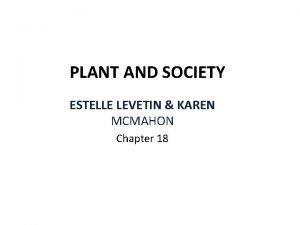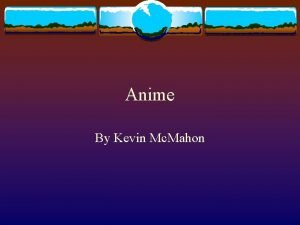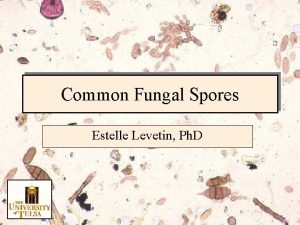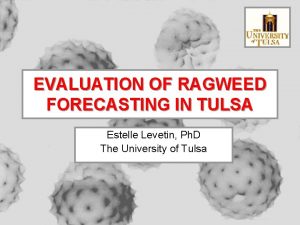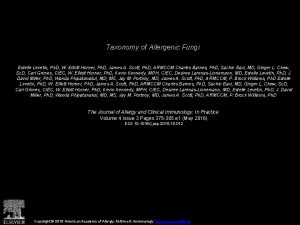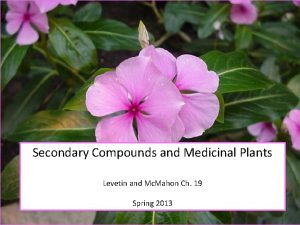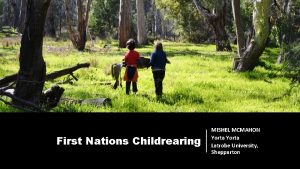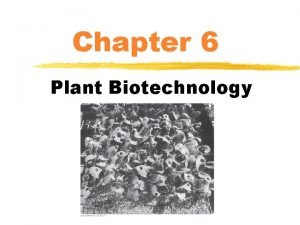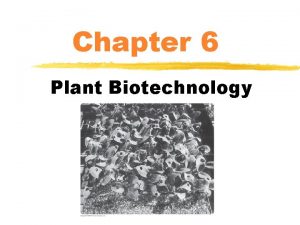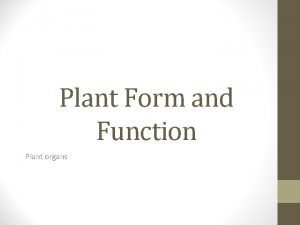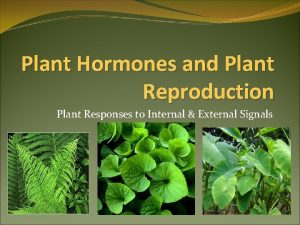PLANT AND SOCIETY ESTELLE LEVETIN KAREN MCMAHON Chapter




















- Slides: 20

PLANT AND SOCIETY ESTELLE LEVETIN & KAREN MCMAHON Chapter 18

CLOTH MAKING • • • Plant fibers Fibers used to wave cloths-Textile fibres Cordage fibers Filling fibres Animal fibres (wool, silk) protein Plant fibres cellulose

• Surface fibres on covering of seed, leaves or fruits • Linen are soft fibres or bast fibres (dicot trees) • Hard fibre from vascular bundles in veins (both xylem and phloem) • Monocot leaves source of hard fibres (Manila Hemp) • Hard fibres have high lignin than soft fibres

Extracting Fibres • Fibres separated from source material through Ginning • Soft fibres extracted from stem through Retting • Degradation of soft tissues through microbial action, leaving tough fibres strand intact and freed • Decortication-Unwanted tissues scraped away by hand or machine for hard fibres

Spinning into yarn • Fibres freed from source then cleaned • Fibres are combined and laid parallel to each other to form a strand • Strand stretched or pulled with fingers and individual strands are twisted together to form thread • Spindle made spinning easier • Rotation of spindle that twists and holds the fibres together forming a yarn

Cotton • Arab introduced cotton to Muslim Spain • Qutn • Top cotton producing country China • United States, India, Pakistan, Egypt, Brazil

THE COTTON PLANT • Most popular natural fiber accounting for half of world’s textiles • Cloth made from seed fibres from Gossypium sp. • Malvaceae • 20 -30 species in genus Gossypium native to parts of Asia, Africa and Central America

• Cotton is shrubby plant with palmately lobed leaves • Most species perennial • Grows best in warm climate • Flower color from white to purple • Fruit is capsule (commercially called ball) when open splits along five seams, revealing white mass of fibres

• In cotton plant, fibres are hairs that extending from seed coat of each of 10 or so seeds in every fruit • 20, 000 seed hairs may grow from single seed • Each cottonseed hair (actually a single seed coat cell) is twisted, hollow strand of cellulose upto 7. 62 cm (3 inches) in length and flattens at maturity

• • • Seed hairs may be Lint or staples (long, slender fibres) Linters (shorter, fuzzy hairs) High quality cotton from longest of lint Purity of cotton cellulose (90 %) and natural twist make cotton excellent fibre for spinning into yarn

SEM Cotton fibers

Cotton Gin • Cotton balls mature 50 -80 days after fertilization • Defoliants sprayed, leaving only bolls for picking • Machine process • Harvested bolls or fibres sent to a gin • During ginning lint is removed from seed

Old and New Varieties of cotton • Commercially new important sp. are G. hirsutum and G. barbadense • G. arboreum and G. herbaceum old varieties

Operation of Cotton Gin

• Saw gin a roller studded with spikes covered by metal mesh • Spikes draw in lint but seeds do not pass through mesh and left behind • Whitney’s Gin separates cotton fibers from seed much quickly • Whitney’s Gin produce 50 pounds (22. 5 kg) of cotton fibres per day

• Cotton seeds source of cottonseed oil • Ginning fibres packed into large bales and graded for quality • Graded bales shipped to yarn or cloth manufacturers • Lint is straightened, sorted into parallel bundles of similar size in preparation for spinning into yarn

Finishing and Sizing • May alter the appearance and modify function of textile • Plant fibres bleached to remove natural color • Bleaching may involve soaking into sour milk or cow’s dung • A bath in buttermilk followed • After washing cloth spread on grass until exposure to sun bleached it white

• Macerization, finishing process improves strength, luster and affinity for dyes • Cotton macerization involves passing cotton through caustic soda (Na. OH) • Permanent press involves shape-retentive finish • Cellulose fibres like cotton wrinkle and crush easily • Chemicals applied that cross-link cellulose fibres giving built-in-memory , shape of garment retained even after laundering, ironing

Bio-engineered Cotton • Bollgard trade name for transgenic cotton • Incorporation of toxin producing genes from Bacillus thurigiensis • Bt toxin effective insecticide against three particularly noxious pest of cotton-cotton bollworm , pink bollworm, tobacco budworm

• Agracetus-biotech company • Working on transgenic cotton plants that combine breathability and feel of cotton cloth with low-maintenance and heatretaining properties of polyester • Created transgenic cotton plant that fill the hollow middle of cellulose seed hairs with small amount of polyester material
 Levetin
Levetin Christiana mcmahon
Christiana mcmahon The cockroach by kevin halligan
The cockroach by kevin halligan Estelle v. gamble
Estelle v. gamble Estelle v. gamble
Estelle v. gamble Estelle millet
Estelle millet Estelle libert
Estelle libert Paul pagnol
Paul pagnol Estelle oldham jill faulkner
Estelle oldham jill faulkner Estelle devos
Estelle devos Estelle levin
Estelle levin Estelle malaquin
Estelle malaquin Estelle setan national treasury
Estelle setan national treasury Tronsmo plant pathology and plant diseases download
Tronsmo plant pathology and plant diseases download Tronsmo plant pathology and plant diseases download
Tronsmo plant pathology and plant diseases download Albugo eye
Albugo eye Gertler econ
Gertler econ Sem vi
Sem vi Plant introduction in plant breeding
Plant introduction in plant breeding Plant introduction in plant breeding
Plant introduction in plant breeding Chapter 8 section 1 what are earthquakes
Chapter 8 section 1 what are earthquakes
